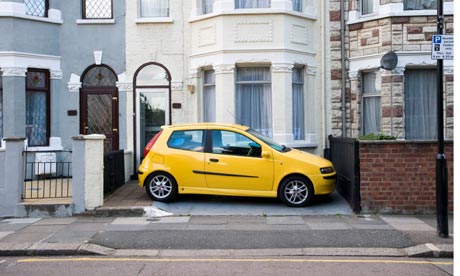via @iheartnixon
A London Wildlife Trust report shows the capital is greying, with green spaces increasingly paved over or built on

London's front gardens are increasingly being given over to parking space. Photograph: Alamy
The biggest survey ever conducted of private space in the capital, taken by the London Wildlife Trust, shows it is getting greyer – threatening its reputation of being one of the world's greenest cities because of its extensive public parks and gardens.
The city is losing the equivalent of two-and-a-half Hyde Parks of greenery a year from its private, domestic gardens – about 3,000 ha (7,410 acres), says the report. It goes on to say that this is undermining wildlife and adding to the "heat island" effect, which sees temperatures in cities much higher than in the countryside and contributes to drainage problems as water floods more quickly into drains.
The report compared city-wide aerial surveys taken in 1998 and 2006, and found that domestic gardens make up nearly 24% of the city's total area, or 37,900 ha. Of this, about 22,000 ha, or 14% of the city, is covered with lawns and tree canopy. The report estimates that there are around 2.5 million trees in private gardens.
But as a result of changing fashions in garden design and management, the area of plant-covered land dropped 12% during that period, while the area of hard surfacing increased by 26%.
The survey also found that Londoners were fast discarding their lawnmowers to build sheds. The area of lawn decreased by 16% and that of new garden buildings increased by nearly 55%.
Although the report was not detailed enough to identify which boroughs were destroying their gardens, suspicion fell equally on both rich and poor boroughs. Anecdotal evidence suggests that London's greener outer suburbs, where gardens are around 10 times larger on average than those in inner city boroughs, are increasingly paving over their green space as a fashion statement. However, landlords in inner city boroughs may be turning to concrete in order to avoid paying for garden upkeep.
"The speed and scale of the loss is alarming," said Matthew Frith, deputy chief executive of London Wildlife Trusts. "Collectively these losses detrimentally affect London's wildlife and impact on our ability to cope with climate change. It's never been more important that Londoners understand the value of the capital's gardens."
The reasons suggested for the decline of the garden green space include insurance companies insisting that trees are removed to avoid claims for subsidence, the infilling of large gardens to provide building land space, consumer pressure to make gardens look more like living rooms and the rise of the shed as a home working space.
"There has been a great gap in our knowledge about London's private gardens. People are taking more interest in wildlife gardens but everyone can do something to make London greener," said report author Chloe Smith.
According to Smith, nearly two thirds of all London's front gardens are now covered with hard surfaces, whereas back gardens have around 33% lawn and 22% hard cover. "An area of vegetated garden equivalent to 21 times the size of Hyde park was lost between 1998 and 2006," she said.
Surprisingly, the survey shows that the 2.5m garden trees in London cover nearly 6,700ha, or 4% of all greater London. This makes London technically one England's largest privately owned forests, bigger than Sherwood, and around one third the size of all the woodland owned by the National Trust.
If all the public gardens and parks of the capital are included, London would almost certainly be one of the greenest mega-cities in the world. A study of 386 European cities in 2009 found green space coverage averaging 18.6%.
Other British cities including Leeds and Edinburgh are thought to be comparable to London with around 25% garden cover, said Smith.
 #supercarrinho @supercarrinho
#supercarrinho @supercarrinho

Nenhum comentário:
Postar um comentário
super carrinho. faça as idéias rodarem aqui também.
obrigada pela participação no debate.